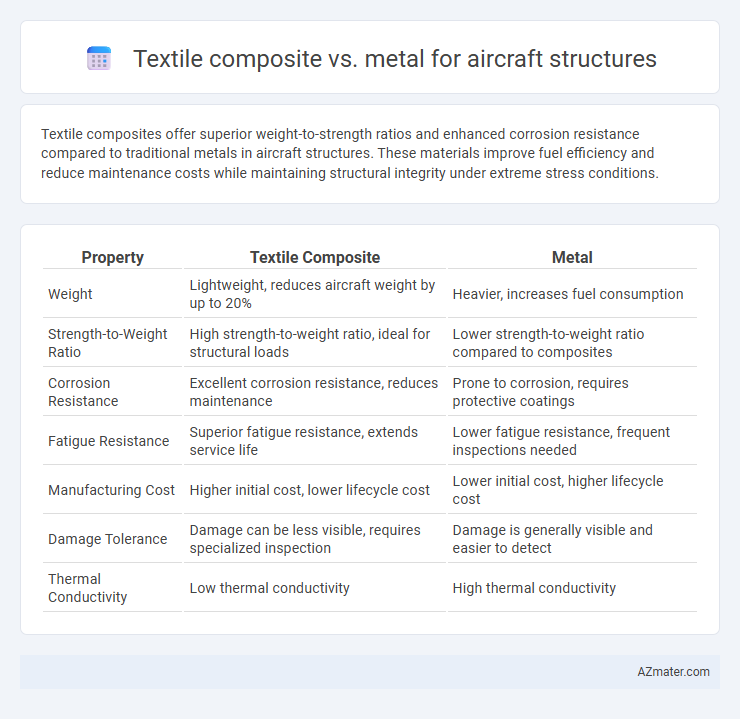Textile composites offer superior weight-to-strength ratios and enhanced corrosion resistance compared to traditional metals in aircraft structures. These materials improve fuel efficiency and reduce maintenance costs while maintaining structural integrity under extreme stress conditions.
Table of Comparison
| Property | Textile Composite | Metal |
|---|---|---|
| Weight | Lightweight, reduces aircraft weight by up to 20% | Heavier, increases fuel consumption |
| Strength-to-Weight Ratio | High strength-to-weight ratio, ideal for structural loads | Lower strength-to-weight ratio compared to composites |
| Corrosion Resistance | Excellent corrosion resistance, reduces maintenance | Prone to corrosion, requires protective coatings |
| Fatigue Resistance | Superior fatigue resistance, extends service life | Lower fatigue resistance, frequent inspections needed |
| Manufacturing Cost | Higher initial cost, lower lifecycle cost | Lower initial cost, higher lifecycle cost |
| Damage Tolerance | Damage can be less visible, requires specialized inspection | Damage is generally visible and easier to detect |
| Thermal Conductivity | Low thermal conductivity | High thermal conductivity |
Overview of Aircraft Structural Materials
Textile composites in aircraft structures offer superior strength-to-weight ratios and corrosion resistance compared to traditional metals like aluminum and titanium, enhancing fuel efficiency and performance. Metal materials provide ductility and high impact tolerance, making them essential for components requiring damage tolerance and high load capacity. Advances in composite manufacturing have increasingly allowed for tailored mechanical properties, reducing structural weight while maintaining safety and reliability in modern aerospace designs.
Key Properties of Textile Composites
Textile composites offer exceptional strength-to-weight ratios, making them ideal for lightweight aircraft structures that require high mechanical performance and fatigue resistance. Their superior corrosion resistance and enhanced damage tolerance improve structural durability compared to metals like aluminum and titanium. The inherent anisotropic properties of textile composites allow tailored stiffness and flexibility, optimizing load distribution and reducing maintenance costs in aerospace applications.
Key Properties of Metals in Aerospace
Metals used in aerospace, such as aluminum alloys, titanium, and nickel-based superalloys, offer exceptional strength-to-weight ratios, high fatigue resistance, and excellent thermal conductivity. Their ability to withstand extreme temperatures and mechanical stress makes them ideal for critical structural components and engine parts in aircraft. Corrosion resistance and ease of fabrication further enhance metals' reliability and longevity in demanding aerospace environments.
Weight Comparison: Textile Composites vs Metals
Textile composites offer significantly lower density compared to traditional metals like aluminum and titanium, resulting in weight savings of up to 30-50% for comparable aircraft structures. Their high strength-to-weight ratio enhances fuel efficiency and payload capacity by reducing the overall aircraft mass. Despite metals providing more established fatigue resistance, advancements in textile composites continue to improve durability while maintaining superior weight reduction benefits.
Strength and Durability Factors
Textile composites offer superior strength-to-weight ratios compared to traditional metals, enhancing aircraft structural efficiency by reducing overall weight while maintaining high tensile strength. Their corrosion resistance and fatigue durability significantly outperform metals, leading to extended service life and lower maintenance costs in aerospace applications. Despite metals like aluminum and titanium providing excellent impact resistance and damage tolerance, advanced textile composites exhibit remarkable fatigue crack resistance and structural integrity under cyclic loading conditions.
Corrosion Resistance and Environmental Impact
Textile composites exhibit superior corrosion resistance compared to metals, as they are immune to rust and degradation caused by moisture and chemical exposure, significantly reducing maintenance costs for aircraft structures. The environmental impact of textile composites is lower due to their lightweight nature, which enhances fuel efficiency and decreases carbon emissions during flight. Metals, primarily aluminum and titanium alloys, require extensive mining and energy-intensive processing, leading to higher ecological footprints and susceptibility to corrosion under harsh environmental conditions.
Manufacturing Processes and Costs
Textile composites in aircraft structures offer advanced manufacturing processes such as automated fiber placement and resin infusion, which enable lightweight, high-strength components with reduced labor intensity compared to traditional metal fabrication involving machining, forming, and welding. The cost of producing textile composites is often higher initially due to material expenses and specialized tooling, but overall lifecycle costs can be lower due to weight savings leading to fuel efficiency and reduced maintenance. Metal structures benefit from well-established, faster manufacturing techniques and lower material costs but generally incur higher operational expenses owing to greater weight and susceptibility to corrosion.
Repair and Maintenance Challenges
Textile composites in aircraft structures offer superior corrosion resistance and weight reduction compared to metals, but they present complex repair challenges due to the need for specialized materials and techniques. Metal structures benefit from well-established, cost-effective repair processes and readily available tools, making routine maintenance more straightforward. However, metals are prone to fatigue and corrosion, necessitating frequent inspections and repairs that may increase long-term maintenance demands.
Safety and Performance Considerations
Textile composites in aircraft structures offer superior strength-to-weight ratios and enhanced fatigue resistance compared to traditional metals, significantly improving fuel efficiency and overall performance. Unlike metals, composites exhibit excellent corrosion resistance, reducing maintenance costs and enhancing long-term safety. However, the impact damage tolerance and inspection complexity of textile composites require advanced monitoring techniques to ensure structural integrity under operational stresses.
Future Trends in Aircraft Structural Materials
Textile composites are increasingly favored in aircraft structures due to their superior strength-to-weight ratio, corrosion resistance, and design flexibility, promising significant fuel efficiency improvements. Advanced fiber-reinforced polymers (FRPs) with enhanced thermal stability and damage tolerance are shaping future aerospace materials, surpassing traditional metals like aluminum and titanium in performance. Innovations in hybrid composites integrating metal layers aim to optimize load distribution and impact resistance, driving the next generation of lightweight, durable aircraft components.

Infographic: Textile composite vs Metal for Aircraft structure
 azmater.com
azmater.com